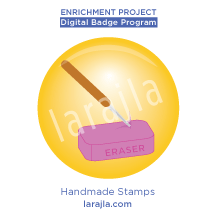 You can make a handmade (physical) stamp to use as a rubber stamp with a variety of materials. Their usage completely depends on the materials from which they are made.
You can make a handmade (physical) stamp to use as a rubber stamp with a variety of materials. Their usage completely depends on the materials from which they are made.
Steps
Considerations
1. Ink and paint.
Depending on the porous nature of your stamps, some may require paint or ink to be effective. Both come in many varieties . . . for example you can get pigment, dye, StazOn®, embossing and distress inks from hobby stores. There are even more types of paint. Read about their uses as well as cleaning information. Then, try a few of these on your stamps. Keep a list as you experiment to refer to as you make more stamps.
2. Test.
Always test your stamps when you are making them. If you don’t like what the stamped area looks like, adjust your stamp and try again. This is necessary even for purchased rubber stamps which might not give a clear print.
3. Pad.
You may find you need to get a little extra padding to get a good impression from your handmade stamp. If you have a pad of paper or a sheet of foam under the item you are stamping on, it will “give” a bit and allow you to get a better impression. Test this by stamping with and without a pad under a sheet of paper to see the difference.
4. Cleaning.
Some inks and materials require special cleaning. For standard dye / pigment inks, you can use baby wipes, special stamp cleaners, etc. Be sure to track which cleaners work best with the medium / stamp you are testing. Use this for your reference.
Stamp-making materials
5. Potatoes and fruit.
When you carve stamps out of food, be aware that the stamps won’t last long. You will probably want to use paint instead of ink because of the porous nature of the “stamp.” To make food stamps, slice it in half. Draw your design and carve it out using kitchen tools. Alternatively, press down with a cookie cutter, remove all the potato outside the cutter and remove the cutter. Food stamps do not hold detailed images. Apply paint and stamp. Find more information online and create a food stamp.
6. Fun foam shapes.
You can place fun foam shapes on any hard flat surface to make a stamp. This includes jar lids, blocks of wood, etc. Some fun foam shapes are not stickers, so you’ll need glue to attach them to the block. Don’t be afraid to adjust the shapes you have . . . you don’t want yours to look like everyone else’s. Make a fun foam stamp.
7. Foam pads.
Foam pads can be found in the pharmacy department of many stores. These include foot cushions for corns, bunions and calluses. If you use these, make sure the plastic skin is removed as it resists ink.
In addition, some “foam” material can be heated and formed into a stamp shape which it holds when cool. Check out the available shapes and look at how you can use them to create your own designs with them.
8. Meat trays.
Using the foam from a meat try, draw a design and cut it out. Attach the foam to a solid base (wood, acrylic, etc.). Test your stamp.
9. Rubber bands.
Wrapping a solid piece in rubber bands gives you a textured background. This works on brayers, acrylic/wooden rods, paper towel rolls, etc. Create a stamp this way and test it.
10. Sponges.
All sponges are not created equal. For more texture, larger holes may look cool. This won’t hold a design, however. Experiment with different types of sponges to see what you can come up with.
11. Carve erasers (rubber).
For carving stamps, erasers are the easiest. Be careful to choose an eraser that doesn’t crumble. The easiest rubber to carve is the rubber eraser on a pencil. Check to make sure the rubber is not hard / old. You can also use larger erasers from the art department at your local store. Get at least two different types of erasers and see the differences in your stamped images.
Alternatively, you may want to watch videos of others carving stamps to see how it is done.
12. Carve linoleum (vinyl).
You’ll need Speedball linoleum carving tool for this. It is a good investment as this will make your life a lot easier. The blades come in various shapes and sizes so you can carve without undercutting your design. Check out videos on carving linoleum.
13. Found objects.
Sounds crazy? Grab a few toy cars, run the tires through ink and see the pattern you get. Need more ideas, try a few of these:
- Bubble wrap — It’s just not for stress relief
- Buttons
- Faux leaves and flowers
- Bottle ends (circles)
- Plastic canvas
14. Don’t stop experimenting!
Continue exploring your home, local resale shops and more for unique items to use as stamps. Don’t limit yourself stamping on paper, either. You can stamp on anything that “stays still long enough.”
Sites to Explore
- www.mitchklink.com/letterboxing/stamps.htm
- groups.yahoo.com/neo/groups/CarvingConsortium/info
- letterboxing.pragerfamily.net/stampmaking.html
- www.carvingconsortium.com
- alteredbelly.blogspot.com/2010/01/found-object-stamping.html
- www.cindyderosier.com/2012/05/found-object-stamping.html
- www.carlemuseum.org/studioblog/?p=1293
Leave a Reply